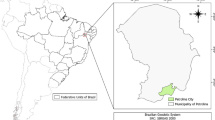Abstract
This paper gives an overview of a major application of modern geospatial tools such as remote sensing, GIS and GPS, i.e., 3S technology in estimating travel demand along Indian roads by considering the study area, Tiruchirappalli urban city in Tamil Nadu. In the study, an attempt was made to estimate travel demand based on the current land-use classification as the pattern of travel depends on the type of land use activity in a zone. IRS high resolution image Cartosat-1 of year 2009 was used to extract the land-use information required. The travel demand model developed was validated with the field obtained OD-matrix to understand the accuracy of the method considered.











Similar content being viewed by others
References
Abrahamsson, T. (1998). Estimation of origin–destination matrices using traffic counts—A literature survey. Interim Report, International Institute for Applied Systems Analysis, Austria.
Bell, M. G. H. (1991). The estimation of origin–destination matrices by constrained generalized least squares. Transportation Research Part B—Methodology, 25(1), 13–22.
Bera, S., & Rao, K. V. K. (2011). Estimation of origin–destination matrix from traffic counts: The state of the art. European Transport Trasporti Europei, 49, 3–23.
Cascetta, E. (1984). Estimation of trip matrices from traffic counts and survey data: a generalized least squares estimator. Transportation Research, 18B(4/5), 289–299.
Cascetta, E., Papola, A., & Carteni, A. (2005). Prediction reliability of the transport simulation models: A before and after study in Naples, In Proceedings of 2005 European Transport Conference, Strasbourg, October 3–5.
Chen, H., & Barahimi, H. (1999). Guidelines for local travel demand model development, 14th Annual EMME/2 Users conference Chicago, Illinois.
Coskun, H. G., Alganci, U., & Usta, G. (2008). Analysis of land use change and urbanization in the Kucukcekmece water basin (Istanbul, Turkey) with temporal satellite data using remote sensing and GIS. Sensors, 8, 7213–7223.
Deng, B., Hu, J., Dai, Z., Li, H., Zhang, Z. (2009). Using 3S Technology to Estimate O–D Matrix in Changyi district in China. In Proceedings of the 12th International IEEE conference on Intelligent Transportation Systems, St. Louis, USA, October 3–7.
Eisenman, S. M., & List, G. F. (2004). Using probe data to estimate O–D matrices, IEEE Intelligent Transportation Systems conference Washington. D.C., USA, October 3–6.
IRC:SP:30 (2009) Manual on economic evaluation of highway projects in india (Second Revision), Indian Road Congress.
Jeer, S., & Bain, B. (1997). Traditional color coding for land uses, Report—American Planning Association.
Lillesand, T. M., Kiefer, R. W., & Chipman, J. M. (2003). Remote sensing and image interpretation. New York: Wiley.
Litman, T. (2012). Land Use Impacts on Transport How Land Use Factors Affect Travel Behavior, Report by Victoria Transport Policy.
Liu, J., Zhuang, D., & Liu, M. (1999). An operational state land use/cover monitoring system in china based on remote sensing and GIS technology. In Towards digital earth—Proceedings of the international symposium on digital earth science press.
Lo, H. P., Zhang, N., & Lam, W. H. K. (1996). Estimation of an origin–destination matrix with random link choice proportions: A statistical approach. Transporation Research—B., 30(4), 309–324.
Marzano, V., Papola, A., & Simonelli, F. (2009). Limits and perspectives of effective O–D matrix correction using traffic counts. Transportation Research Part C, 17, 120–132.
Parthasarathy, C., Kumaresan, K., Sumbrui, C., Kumar, S., Radhakrishnan, N., & Mathew, S. (2011). Land use and land cover assessment along Tiruchirappalli city using remote sensing. The IUP Journal of Earth Sciences, 5(1), 60–68.
Reis, S. (2008). Analyzing land use/land cover changes using remote sensing and GIS in Rize, North-East Turke. Sensors, 8, 6188–6202.
Rhee, J. (2003) Improvement of trip generation forecast with category analysis in Seoul Metropolitan area. In Proceedings of the Eastern Asia Society for Transportation Studies (Vol. 4).
Acknowledgments
The authors are grateful to National Remote Sensing Centre (NRSC) Hyderabad for providing the necessary IRS data for the study. We are also grateful to the Local Planning Authority of Tiruchirappalli for providing the base map of urban Tiruchirappalli city and permitting us to use it for our study. We are thankful to the Tiruchirappalli corporation office officials to have given us the necessary population census data required for our work.
Author information
Authors and Affiliations
Corresponding author
Additional information
Nisha Radhakrishnan: ISRS Membership No. L-3606.
About this article
Cite this article
Radhakrishnan, N., Aswathy, R. & Mathew, S. Studying Land Use Travel Demand Interaction Using 3S Technology for Tiruchirappalli City. J Indian Soc Remote Sens 45, 815–824 (2017). https://doi.org/10.1007/s12524-016-0616-z
Received:
Accepted:
Published:
Issue Date:
DOI: https://doi.org/10.1007/s12524-016-0616-z




